Thermal
So I got into the hands of this wonderful device – the Thermal Imager Seek Thermal from Dadget. And, frankly, absolutely no desire to write a review on it. Well, in fact, who needs another unpacking, inspection of the packaging, pictures of the battery, pipe, cat, traces and wiring in the wall? This all already was. If to you nevertheless became curious, then there, on GT, there are some fine and very detailed reviews of this device. I will outline a few characteristic:
And I do not even say anything about the characteristics, why repeat it. 🙂 Since I have here “Hackside type”, and in fact an experimental laboratory for suffering with various amusing nonsense, this device will serve as another tool capable of answering sometimes arising questions. But first things first.
▌Problems
To choose from, I was offered an iOS or Android solution. Because I already ate the apple axes and I’m going to get rid of the iPhone and take the next device on the android, then the thermal imager was taken on the android. Fortunately I have an old Xperia Z smartphone and I planned to use it for the first time. Support for OTG in it is, the mouse-keyboard-flash drives in it work, power is received. Problems should not be … Naive, I forgot that simple solutions do not work for me. At one time, I even branded Arduin, while others just did not yet exist, could not be stitched. I did not want to work out of the box, even crack! I had to solder the programmer and then, according to dedovski, saw in assembler. And I wanted so … Therefore I do not like them – a child’s trauma.
In short, it did not take off. Soft got up, and the phone does not see the camera. Generally does not see. No, does not even see that something is connected to the port. Usually he still undermines me. And here not. I, without thinking twice, blew up into the local store of radio components, where the director also has some kind of Xperia just my new, the seller also has some kind of androidophone. In general, their people, will not give a chasm.
We put Glory, the seller, the software on its Chinese OUKITEL 6000 Pro – we stick in the thermal imager. Working. Works great. I run to the director. Basil, zyryas I have a toy, but I need your phone! We put the software on Xperia Z1C – everything also works fine.
But with the software, what kind of hell is going on. The fact is that Sony phones traditionally have a USB socket located on the side.
And the picture is at an angle, but the camera’s software is not only that it does not know how to turn it, So still attached to the accelerometer of the phone tightly. You can prevent the screen from rotating in the phone itself, but it will not work. The interface of the program and the picture will also rotate. Solve the problem for programmers of this software for fifteen minutes with breaks, but they do not even try to solve the problem. For a year and a half, the people have been swearing at this, but it’s still there.
Okay, the screen orientation is fixable. You just need to wire the wires for a convenient connection, and hamper the rest. The question is not this? What kind of horn does it not work for me? I stick in my Xperia Z aman – got started. O_o is working. Well, it’s clear – there’s probably not enough power for the port. SchA, we’ll figure it out! I buy USB pins and plugs and run to my studio.
Further dances around Xperia Z did not lead to anything. So she did not want to run there anymore. Not in any. And it was not the food. I then watched the oscillograms of the inclusion – well, yes, there is a failure to charge the capacitors, but not large. Not more than connecting a USB flash drive.
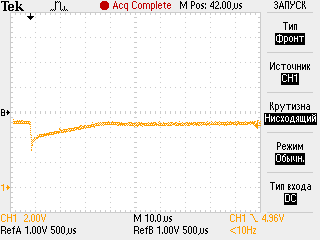
And if you distort the wire, the capacitors will be already charged and should have started. The voltage does not drain. Problems should not be. Connecting external power, in the cut, did not work. Those. It seems like it’s still in the software, not in the hardware.
I did not understand, I was not at that time, I took the SGS Note 10.1 tablet. And he has a wide-area wide connector. I bought an OTG cable.
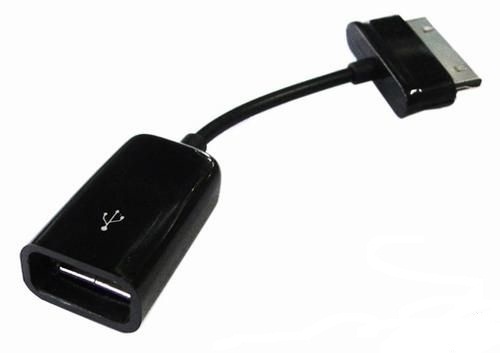
We need OTG, a simple charger, there are not enough contacts in the connector and its tablet does not see. He gutted the lace, cut out the scarf, and sealed it all.
And that the whole design did not wobble and did not try to break the connector, I modeled it in Fusion360 and printed the bridging tool:
Archive with the model of the thermal imager, as well as all parts of this Pribluda in stl. Whether it is a lot of to whom it is useful.
I spied it all on the tablet and now it’s gone.
▌Working
As soon as everything worked, I immediately wanted to get answers to the long-standing questions concerning the table of my printer. First, how much the table is warming up evenly. The table size is 300x300mm and the edges were noticeably cooler than the center. At least on sensations. Now I could see it and take measures to solve the problem.
Also I saw how much the external environment affects the temperature of the table. I think it’s not a secret that drafts greatly spoil the situation, uneven cooling of the table and the printed part leads to its unraveling from the table, as well as rupturing the layers – delamination. Even with closed windows and the absence of drafts in the workshop, there was a sharp dip along one edge. I thought it was a table problem that he just did not warm up in that place. It turned out not. It’s just that we walked backwards past the printer in this place and with their massive carcasses pumped cold air. On greater details, it led to detachments from the table.

Installation of simple cardboard walls improved the picture with the uniformity of warming up the table and the part. Better, of course, a fully enclosed camera. But here it is difficult to implement because of the design with a movable table.
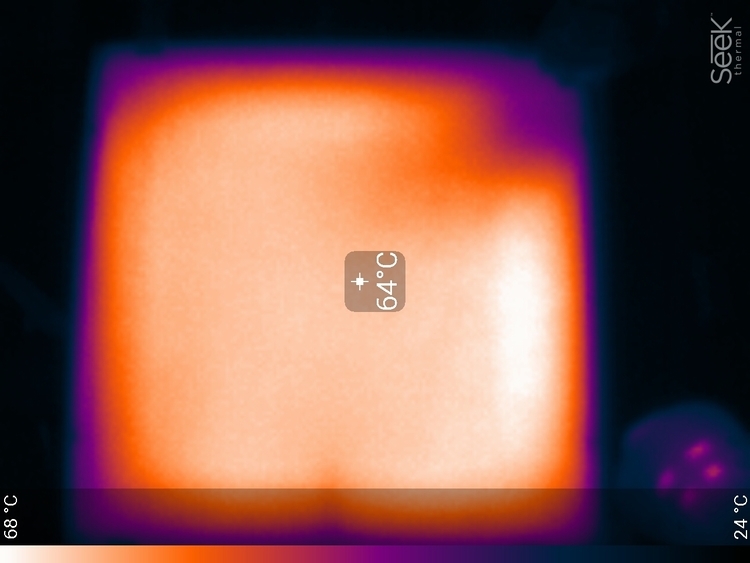
At the same time checked how much the native thermistor is lying. The fact that he is lying is beyond doubt, he stands under the table, in the center. There is still an air gap and glass up to the detail. Although here the thermal imager is not such a device. Accuracy is very conditional. Much depends not on the actual temperature of the object, but on how it radiates.
The second issue was the system for blowing the part. When printing overhangs, if they do not quickly cool, then naturally cooling, they strive to bend up and hook on the nozzle. Therefore put a powerful blowing. But there are problems. The extruder design does not give much maneuver to make a full-fledged blowing from all sides. Too thin an air channel is obtained. I printed a system with two tubes, blowing from both sides. But did it make sense at all? Check the direction of the flow is quite difficult. I tried to put alcohol on the table and watch for its evaporation, but it still was not obvious.
And here I just heated the table and lightly blew from the cooler, turning it on 10%, I looked at the thermal imager and everything immediately became clear . It turned out that it was not blowing where it seemed. Apparently the air by inertia flies further. As a result, at low speed, nothing falls into the nozzle at all.
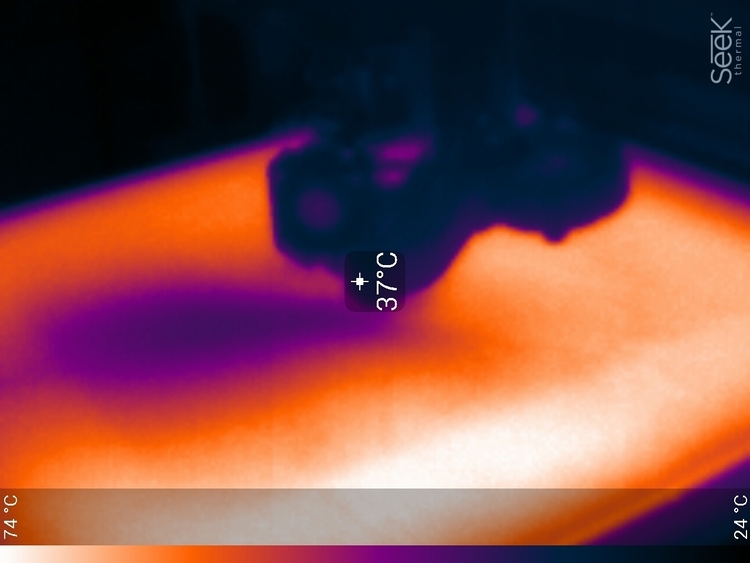
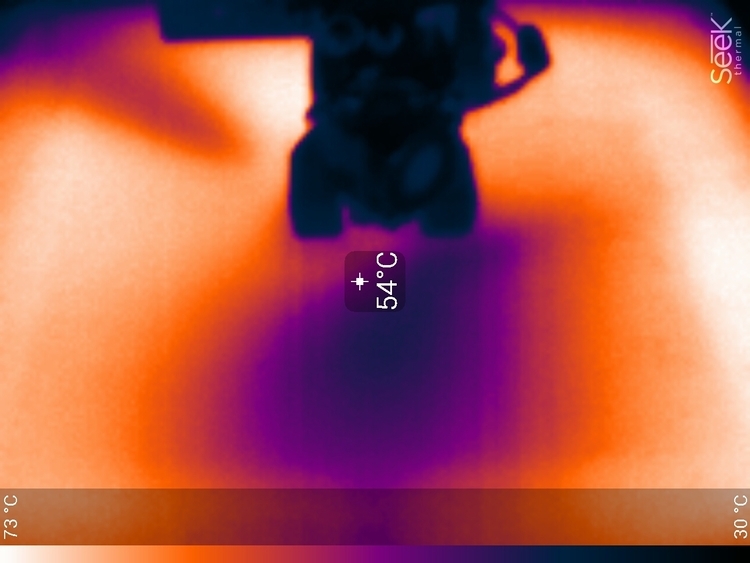
Moreover, it blows only from one nostril, in fact. Here, apparently, is how the stream flows after the snail. The tube is short there. And only at high speeds it starts to blow as it should and covers the entire print area. Therefore, I have some high temperature plastics bounced off the table starting at a certain print height – there was a fan turned on, plus he needed time to do that, To chisel the surface and the detail tore off.
In general, I will think over the alteration. Fortunately I will not do it blindly now.
Estimated the work of cooling the thermal barrier. The essence of the thermal barrier is that plastic from solid to liquid passes jerk than the zone of this transition is the better. Because The viscous, but not yet liquid plastic sharply increases the coefficient of friction against the walls and the extruder may not have enough force to push through the plastic. Cork will arise. Especially such a cork like to form on plastics with a low softening temperature, such as PLA. Especially with the retract, when the hot rod on the retract turns back into the thermal barrier, carrying away heat.

I looked at the problem place with a thermal imager to make sure that this trouble does not concern me. Everything above the thermal transition is cooled well. Yes, in fact, we had no problems with that. But once again, it’s nice to look.
At the same time I glanced at the drivers of the footsteps that stand on the RAMPS – the radiators are cold, and the boards heat a little. Looks like the tracks are rather thin. The left driver rotates the extruder. The most loaded engine I have. Therefore, he is clearly hot.
Yes, someone in the comments asked whether it is possible to see with it a separate heating resistor on the board or a tiny SOT23 transistor? See the dark dots? These are the ends of the PLS plug pins with a pitch of 2mm and a diameter of somewhere 0.5mm. They are clearly visible. Also, a resistor or a transistor on the board will be clearly visible. Permission of the thermal imager array and the possibility of focusing on this is more than enough.
And since the printer is on rails with wheels, the carriages roll easily and the engines do not heat up at all. Right now, here’s the engine hammering back and forth, chasing the head at the filling filling, but the engine is dark even on the thermal imager. And already to the touch in general the grave cold blows.

So, from one armed look you can already see where everything is in order, and where you can try to improve the situation.
We go further.
Soldering dryer. It is always interesting which scheme is more effective. Compressor or turbine. The essence of the compressor scheme is that the air is driven by a frog, sitting on a vibrator (here each represents the extent of its depravity). There is a small turbine in the turbine.
The turbine is quieter, cheaper. And received a truly massive distribution. Especially in a cheap station like lukey and other clones. Compressor is more expensive and less common. And noisy. But it has an important property – it can squeeze more air through narrow nozzles. And the air is the main coolant in the dryer and no matter how much it warms the heater and to what temperature. The main thing is how much heat it was possible to deliver to the board.
Therefore, we take two hairdryers, put on them the same temperature, with an external thermocouple, we expose approximately the same (according to sensations, otherwise not check, I looked at the deviation of a piece of paper) A narrow nozzle and begin to warm … Just along the table. Estimate the take-off of the jet. Without baits.
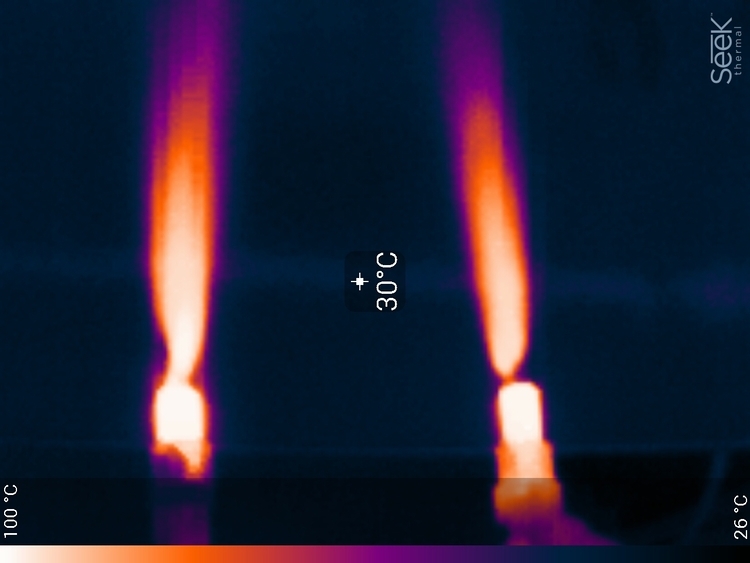
Both hairdryers are included on the maximum flow. While parity. The picture is the same. Dress the nozzle 5mm.
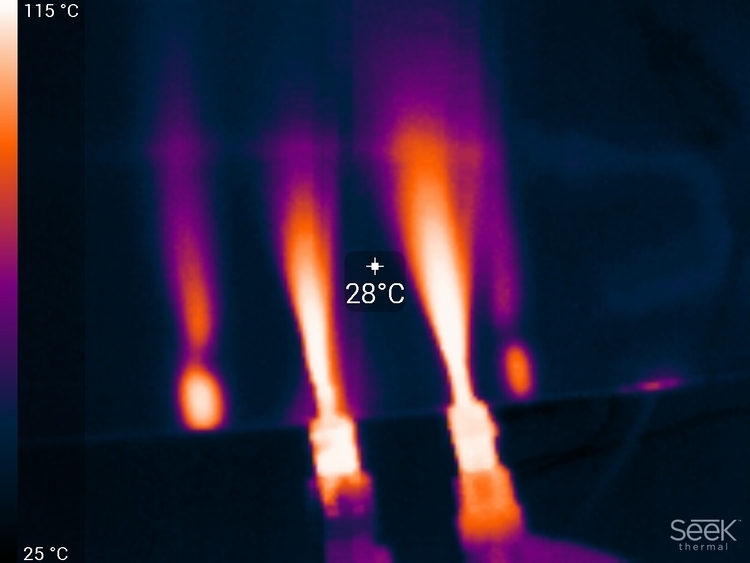
Here the compressor starts to give out the big productivity, in spite of the fact that at the compressor hair dryer we have reduced capacity of a stream to 40% from the maximum (so the instruction about operation commands). The turbine blows as before to its fullest.
Put on the nozzle 3mm. This usually evaporates very small things. The capacity of the compressor remains the same: 40%. The flow of the compressor is much stronger. This can be seen even by the fact that at the exit from the nozzle, the jet does not fly directly by inertia, but sharply expands. This is felt in practice. From the turbine is a feeling that the air does not come out at all. While the compressor produces a noticeable elastic flow.
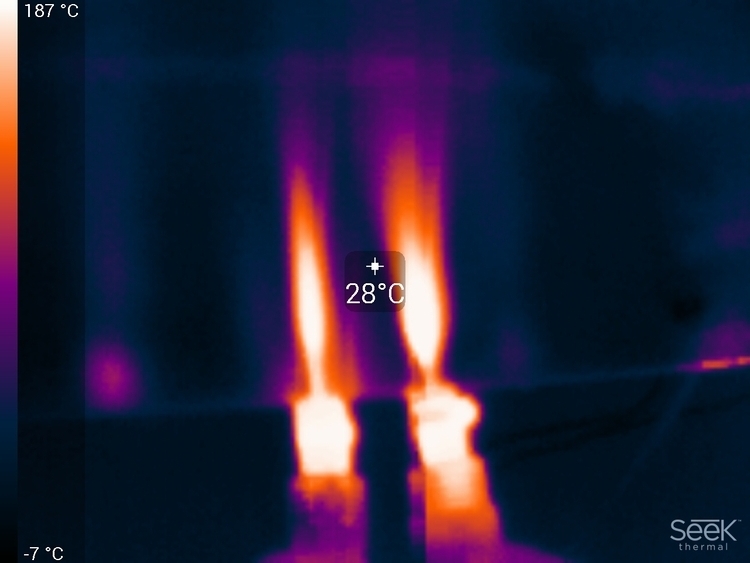
In general, the situation is unambiguous. Although if you worked with a compressor and turbine hair dryer, you yourself probably noticed the difference that the compressor dryer blows away, then the turbo you get to get warm.
▌Duality of the
Back in previous reviews in the comments were questions about the range of the thermal imager. I conducted an experiment, went to the shore of the lake, where fishermen sit on the ice, about 400 meters from the shore and looked:
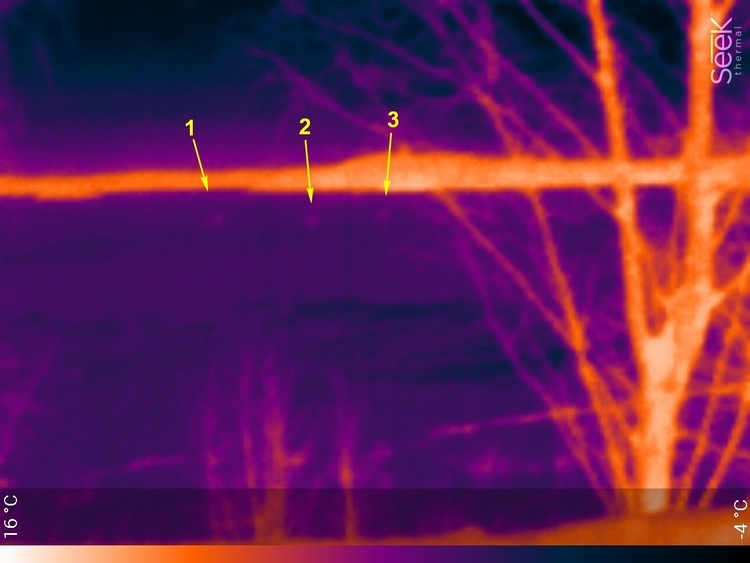
The photo was taken after a few minutes, during this time the first fisherman To pass a tangible distance. Shot on the camera of the tablet.
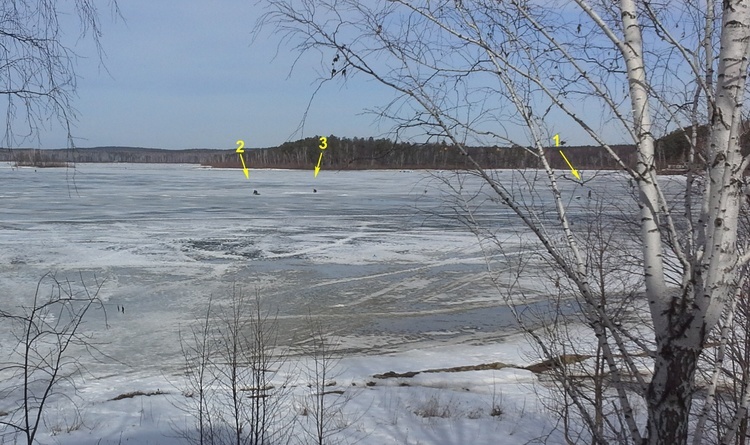
Keep in mind that fishermen with an eye for a long, stationary sitting on ice are dressed VERY warm. So they shine in the infrared range is very weak. Compare with the sunlit forest, on the other side of the lake (about 3km). How can the clothes on the thermal imager’s picture affect the example of my two seals. One of them is red, the second is bald. Their body temperature is approximately the same, about 39 degrees. But Bald is directly lit, while Red, much more strongly insulated, looks less noticeable.
▌ Impressions
The device is extremely entertaining and in some cases makes it possible to calculate what it is extremely difficult to do without it. The same blowing on the printer or how and in what sequence the circuit board is heated during operation. Sometimes it helps to calculate the problem before something burns. Will be actively used now about and without 🙂
Unfortunately, the situation is greatly overshadowed by the curvature of native software, at least in the android version. And the device clearly does not have enough of its camera. With exactly the same angles and synchronized focus. Then it would be possible to paint a high-quality picture from an ordinary camera with an image from an IR-matrix and to receive simply a chic for its informative picture. Yes, it certainly has a mode of displaying images from the camera of a smartphone and a thermal imager at the same time, but they often do not match the parameters of the optics.
▌ Information for bloggers and authors:
The company “Dajet” is interested in publishing independent objective reviews of dajets in various media. The company “Dajet” will gladly provide dadgets for bloggers and authors wishing to test them and write a review.
The device after the writing review remains with the author. The company does not try to tell the author what exactly to write about our product, but asks to show the article before publication. In this case, it is possible to clarify the information and prevent errors. Whether to take into account the comments of the company or not, always remains at the discretion of the author. Read more …
With a 10% discount, you can purchase the Thermal Imager Seek Thermal by specifying the promotional code GT-ST. Promotional code is valid until 27 June 2017








